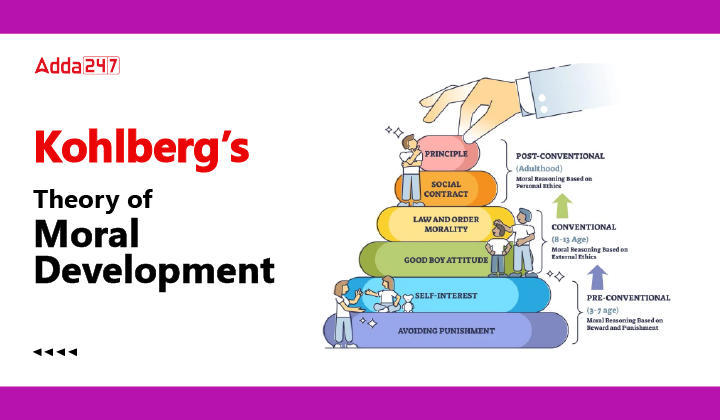Table of Contents
In the Central Teacher Eligibility Test (CTET) exam, Kohlberg’s Theory of Moral Development is a significant topic that examines the stages and progression of moral reasoning in individuals, as proposed by Lawrence Kohlberg. Understanding this theory is crucial for prospective teachers to comprehend their students’ moral growth and decision-making processes, enabling them to create a positive and ethical learning environment. CTET questions related to this topic may assess candidates’ knowledge of the theory’s key concepts, stages, and its application in promoting ethical behavior and addressing moral dilemmas in the classroom, ensuring that teachers are equipped to instill strong moral values in their future students.
Kohlberg’s Theory of Moral Development
Lawrence Kohlberg’s work was modified and expanded upon Jean Piaget’s previous work to form a theory that explained how children develop moral reasoning. Piaget described a two-stage process of moral development. Kohlberg extended Piaget’s theory, proposing that moral development is a continual process that occurs throughout the lifespan. His theory outlines six stages of moral development within three different levels.
Kohlberg’s Theory of Moral Development – Stages of Development
Kohlberg identified three phases or levels of moral reasoning – Post-conventional, Conventional, and Pre-conventional. Each of the levels is linked with complex moral development stages.
| Level | Stage | Social Orientation |
| Pre-conventional | 1 | Obedience and Punishment Orientation |
| 2 | Individualism, Instrumentalism and Exchange/ Instrumental Orientation | |
| Conventional | 3 | Good boy/girl/ Nice Girl, Good Boy Orientation |
| 4 | Law and Order Orientation/ Authority and Social Order | |
| Post-conventional | 5 | Social Contract Orientation |
| 6 | Principled Conscience/ Universal-Ethical-Principal Orientation |
Level 1 – Pre-conventional
At the pre-conventional level we don’t have a personal code of morality. Instead, our moral code is shaped by the standards of adults and the consequences of following or breaking their rules.
| Level/Stage | Age Range | Description |
| I: Obedience / Punishment | Infancy | No difference between doing the right thing and avoiding punishment |
| II: Instrumental Orientation | Pre – school | Interest shifts to reward rather than punishment – effect is made to secure greatest benefit for oneself |
Stage 1: Punishment- Obedience Orientation
This stage includes the use of punishment so that the person refrains from doing the action and continues to obey the rules. For example, we follow the law because we do not want to go to jail.
Stage 2: Instrumental Relativist Orientation
In this stage, the person is said to judge the morality of an action based on how it satisfies the individual needs of the doer. For instance, a person steals money from another person because he needs that money to buy food for his hungry children. In Kohlberg’s theory, the children tend to say that this action is morally right because of the serious need of the doer.
Level 2: Conventional
At the conventional level, we begin to internalize the moral standards of valued adult role models.
| Level/Stage | Age Range | Description |
| III: Conformity and Interpersonal Accord | School – age | The “good boy / girl level. Effort is made to secure approval and maintain friendly relation with others. |
| IV: Authority and Social Order | School – age | Orientation towards fixed rules. The purpose of morality is maintain the social order. Interpersonal accord is expanded to include the entire society. |
Stage 3: Good Boy-Nice Girl Orientation
In this stage, a person judges an action based on the societal roles and social expectations before him. This is also known as the “interpersonal relationships” phase. For example, a child gives away her lunch to a street peasant because she thinks doing so means being nice.
Stage 4: Law and Order Orientation/ Authority and Social Order
This stage includes respecting the authorities and following the rules, as well as doing a person’s duty. The society is the main consideration of a person at this stage. For instance, a policeman refuses the money offered to him under the table and arrests the offender because he believes this is his duty as an officer of peace and order.
Level 3 – Post-conventional
Individual judgment is based on self-chosen principles, and moral reasoning is based on individual rights and justice. According to Kohlberg this level of moral reasoning is as far as most people get.
| Level/Stage | Age Range | Description |
| V: Social Contract | Teens | Mutual benefit, reciprocity. Morally right and legally right are not always the same. Utilitarian rules that makes life better for everyone. |
| VI: Universal Principles | Adulthood | Morality is based on principles that transcend mutual benefit. |
Stage 5: Social Contract Orientation
In this stage, the person is look at various opinions and values of different people before coming up with the decision on the morality of the action.
Stage 6: Universal Ethical Principles Orientation
The final stage of moral reasoning, this orientation is when a person considers universally accepted ethical principles. The judgment may become innate and may even violate the laws and rules as the person becomes attached to his own principles of justice.
Heinz dilemma Experiment
A dilemma that Kohlberg used in his original research was the druggist’s dilemma:
Heinz’s wife was dying from a particular type of cancer. The drug had been discovered by a local chemist, and the Heinz tried desperately to buy some, but the chemist was charging ten times the money it cost to make the drug, and this was much more than the Heinz could afford. Heinz could only raise half the money, even after help from family and friends. He explained to the chemist that his wife was dying and asked if he could have the drug cheaper or pay the rest of the money later. The chemist refused, saying that he had discovered the drug and was going to make money from it. The husband was desperate to save his wife, so later that night he broke into the chemist’s and stole the drug.
Criticism of Kohlberg’s Moral Development theory:
- Kohlberg tried to enhance the views or theory of morality which was briefly described by the Piaget.
- Kohlberg took the help from the studies of dilemma and was also interested in how an individual justify his/her action if he/she was placed in similar moral dilemmas.
- Another criticism of Kohlberg’s theory is that people frequently demonstrate significant inconsistency in their moral judgements. This often occurs in moral dilemmas involving drinking and driving or business situations where participants have been shown to reason at a lower developmental stage, typically using more self-interest driven reasoning (i.e., stage two) than authority and social order obedience driven reasoning (i.e., stage four). Critics argue that Kohlberg’s theory cannot account for such inconsistencies.
- Kohlberg’s stages are culturally biased—that the highest stages in particular reflect a westernized ideal of justice based on individualistic thought. This is biased against those that live in non-Western societies that place less emphasis on individualism.
Download Kohlberg’s Theory of Moral Development Study Notes



 UGC NET Notification 2025 Out, Exam Date...
UGC NET Notification 2025 Out, Exam Date...
 UGC NET Application Form 2025 Starts for...
UGC NET Application Form 2025 Starts for...
 UGC NET Exam Pattern 2025 for Paper 1 an...
UGC NET Exam Pattern 2025 for Paper 1 an...














